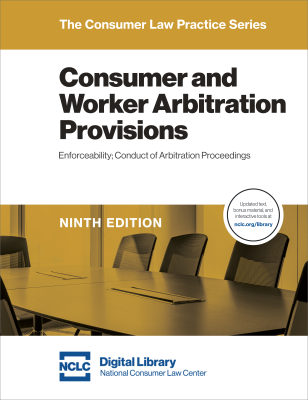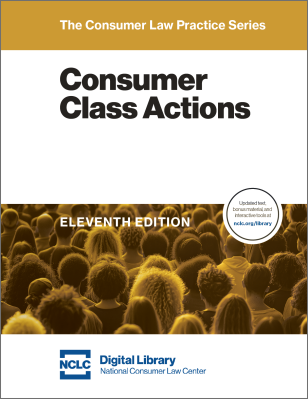The May 16, 2024, decision in Smith v. Spizzirri, 2024 WL 2193872 (U.S. May 16, 2024), is another Supreme Court arbitration ruling. Despite first appearances that the Supreme Court will once again make it more difficult for consumers and workers to litigate in court, this article explains why the decision, at least to some extent is a double-edged sword. Smith makes it almost impossible to appeal federal court decisions enforcing an arbitration provision. Even so, this article explains why Smith could in some cases prove helpful to consumers, workers, and other civil plaintiffs.
In particular, Smith’s requirement that court proceedings be stayed pending arbitration and not dismissed could in certain cases strengthen the hands of consumers and workers who face intractable corporations after a court compels arbitration. This article also explains, despite the holding in Smith, that there are five options that may allow a consumer or worker to avoid a court’s decision enforcing an arbitration provision.
The Decision in Smith v. Spizzirri
In Smith v. Spizzirri, the U.S. Supreme Court considered whether Federal Arbitration Act (FAA) § 3 requires a federal district court to pause or “stay” judicial proceedings pending arbitration after granting a motion to enforce an arbitration provision, or whether the court has the option instead to dismiss the case. Smith deals with a federal lawsuit where a defendant, pursuant to FAA § 3, successfully requests the court to enforce an arbitration provision and the court decided to dismiss the action.
A unanimous Court held that, where one of the parties requests the court to stay the action, the court has no discretion to instead dismiss the lawsuit. This decision requiring a stay instead of a dismissal may sound technical, but it can have significant practical implications for the litigation.
Why the Decision Makes Things Difficult for Workers and Consumers
The FAA has one-sided interlocutory appeal rights. FAA § 16(a) allows defendants an automatic right to an interlocutory appeal of a federal court’s refusal to enforce an arbitration provision. As described in another NCLC article, the Supreme Court in Coinbase, Inc. v. Bielski, 2023 WL 4138983 (U.S. June 23, 2023) held a federal court has no discretion, but must stay all court proceedings until that interlocutory appeal is resolved.
On the other hand, if a federal court enforces the arbitration provision and stays the action, FAA § 16(b)(1) explicitly prohibits a plaintiff from taking an interlocutory appeal of that decision. “Except as otherwise provided in section 1292(b) of title 28, an appeal may not be taken from an interlocutory order—(1) granting a stay of any action under section 3 of this title.”
Before Smith, instead of staying the case, several circuits had held that the court has discretion instead to dismiss the case. And the Supreme Court has said that upon dismissal the plaintiff can then appeal this final adverse ruling. See NCLC’s Consumer Arbitration Agreements § 2.6.3.2. But Smith holds that the court has no discretion to dismiss the case if a party instead requests a stay.
Smith’s practical effect is that consumers and workers now have limited options to appeal federal district court decisions enforcing arbitration provisions. The primary way to appeal the court’s ruling may be to proceed to arbitration, obtain an arbitration ruling, and then appeal that there was no binding arbitration requirement—a particularly unfair process that would require the consumer or worker, to go all the way through the arbitration proceeding on the merits of their claims to challenge the validity of the order requiring that the arbitration proceeding take place.
The fact that adverse rulings to workers and consumers are not appealable while a favorable ruling can be appealed (also stopping the case in its tracks) means that over time arbitration precedent may become even more lopsided in favor of enforcement. Businesses will have shots before two courts to enforce arbitration while workers and consumers will have only one chance to argue the arbitration provision is unenforceable. Moreover, when one federal district court enforces an arbitration provision, other district courts may follow suit concerning the same arbitration provision with no chance of an appellate court reversing that decision.
Forcing the worker or consumer into arbitration in many cases means there will be no option at all for the individual, where the arbitration process is too expensive, or attorneys shy away from representation of individuals in arbitration. In other cases, the arbitration provision or the rules of the arbitration provider makes the arbitration process significantly unfair or unavailable.
Why the Decision Can Strengthen the Position for Workers and Consumers When the Arbitration Process Fails
Smith allows either party to request a stay if the federal court enforces the arbitration provision, and the court has no discretion but to comply. In certain cases, particularly individual actions where AAA or JAMS is designated as the arbitration provider or the arbitration is brought as a mass arbitration, consumers or workers may prefer a stay to a dismissal. For example, following enforcement of an arbitration provision, if a consumer or worker proceeds to arbitration, defendants or even the arbitration provider may refuse to participate in the arbitration. In that case, because the court action has only been stayed, the plaintiff can go back to the same court and seek to resume litigating the case in court.
FAA § 3 requires enforcement of an arbitration provision “providing the applicant for the stay is not in default in proceeding with such arbitration.” If the defendant defaults in its obligation to participate in the arbitration or its non-participation waives the arbitration provision, the individual can then litigate in court despite the arbitration requirement. Similarly, in certain situations a arbitration provider may refuse to or be unavailable to administer the arbitration. See generally NCLC’s Consumer Arbitration Agreements § 9.4.
Going back to the same court—after a stay—means there are no statute of limitations or other practical impediments that may arise if the individual must file a new action if the original case had been dismissed.
Here are situations where a stay may be better for individuals than a dismissal. Note that these examples generally apply when JAMS or AAA is the arbitration provider, but may not apply to other providers that place significant filing costs on an individual claimant or otherwise have one-sided rules in favor of businesses that make arbitration impractical for the individual:
- The business, when it discovers it will have to pay many thousands of dollars to participate in the arbitration (while the consumer or worker pays only a few hundred dollars), refuses to pay its filing fees and the arbitration provider dismisses the arbitration proceeding. Asymmetrical fee structures are found in AAA and JAMS consumer and employment rules, and may be found in some arbitration agreements themselves, or even the court’s order compelling arbitration.
- The business otherwise refuses to participate in an individual arbitration.
- AAA or JAMS rules that the arbitration provision does not meet its due process protocols and refuses to arbitrate the case, including when a business does not register its arbitration provision with the AAA.
- The sole arbitration provider designated in the arbitration provision for some other reason is unwilling or unable to administer the arbitration, including that the provider does not currently exist.
- A company in the past failed to pay its AAA arbitration fees and the AAA refuses to handle future arbitrations with that company.
- A company refuses to participate in a mass arbitration (see NCLC’s Consumer Arbitration Agreements § 10.7), and the consumers or workers then go back to court and seek to proceed as a class action.
Five Potential Ways to Get Around Smith to Overturn Arbitration Enforcement
As described in the prior section, there are reasons consumers and workers may in some cases prefer a stay over a dismissal. But if the preferred result is to overturn the federal court’s decision to enforce the arbitration provision, a stay will prevent the consumer or worker’s appeal. There are five paths that may be available to challenge an adverse decision concerning enforcement of an arbitration provision:
1. File the action initially in state court. FAA §§ 3 and 16 only apply to federal court actions. State procedures may be different, allowing an interlocutory appeal or other procedures to review a ruling enforcing an arbitration provision despite the case being stayed. See NCLC’s Consumer Arbitration Agreements § 2.6.5.1. Moreover, Smith interprets FAA § 3 and is not binding on state court interpretations as to whether a state court action must be stayed or whether it can be dismissed.
In addition, when a federal court defendant seeks an interlocutory appeal of a ruling denying enforcement of the arbitration agreement, a federal court must stay the case pending resolution of the appeal. See Coinbase, Inc. v. Bielski, 2023 WL 4138983 (U.S. June 23, 2023). Coinbase is not binding on state courts which may have discretion to allow the case to proceed while the interlocutory appeal makes its way through the courts. See NCLC’s Consumer Arbitration Agreements § 2.6.5.2.
FAA § 4 allows the defendant in a state court action to enforce the arbitration provision in federal court. If there is federal jurisdiction for the case, the federal court can issue an order “directing the parties to proceed to arbitration.” FAA § 16(b)(2) provides: “Except as otherwise provided in section 1292(b) of title 28, an appeal may not be taken from an interlocutory order— … (2) directing arbitration to proceed under section 4 of this title.” Thus, the state court option may not be helpful if there is federal jurisdiction and the defendant seeks relief under FAA § 4 in federal court.
But if a case in state court is crafted so that there is no federal court jurisdiction, FAA § 4 does not apply. Moreover, bringing the case under FAA § 4 does not in itself create federal jurisdiction. With no federal jurisdiction, only state procedure will determine a plaintiff’s rights to overturn a state trial court’s decision to enforce an arbitration provision, even if the FAA still applies concerning the substantive question as to the enforceability of the agreement.
There may be other reasons to litigate in state court, such as where state court standing requirements are more liberal than federal court requirements. See the state-by-state analysis of state court standing requirements found in the just-released Eleventh Edition of NCLC’s Consumer Class Actions Appendix D. Appendix C of that treatise is a state-by-state analysis of state court class action procedures.
2. Ask the arbitrator to refuse to enforce the arbitration provision. Frequently, arbitration provisions contain a “delegation” clause that the arbitrator and not the court decides the arbitration provision’s enforceability (or AAA or JAMS rules are interpreted as requiring such delegation). In many cases, a court does not decide enforceability, but stays the case and passes that decision to the arbitrator.
A court passing the decision to the arbitrator is not the end of the issue. For example, in the case of AAA and JAMS, consumers and workers can pay a few hundred dollars in arbitration fees, and the defendant then must pay around $5000 for the arbitrator to then decide on the enforceability of the arbitration requirement. If the arbitrator finds the provision is not enforceable, the case goes back to the court that stayed the case. (If the defendant refuses to participate in the arbitration, the case also goes back to the court.)
Of course, there are limits to this approach. It may only be feasible where the arbitration provider’s rules or the arbitration provision allows for workers and consumers to proceed at minimal cost. Moreover, it can be expected that many arbitrators may be biased in favor of their own jurisdiction, and in close cases find that the arbitration provision is enforceable.
3. If no party requests a stay. Smith explicitly holds that where a party requests a stay, the federal court cannot dismiss the case. If both parties are satisfied with a dismissal or if neither party formally requests a stay, the court can dismiss the case. Of course, it is increasingly unlikely that defendants’ counsel will permit this option in the wake of Smith.
Another options is that the plaintiff, seeing that things are not going well, may reach an agreement with the defendant to dismiss the case with prejudice, but reserving appeal rights. In all these cases, following dismissal, the consumer or worker will be able to appeal enforcement of the arbitration provision.
4. Seek permission for an interlocutory appeal under 28 U.S.C. § 1292(b). FAA § 16(b), in limiting the plaintiff’s ability to take an interlocutory appeal, states “Except as otherwise provided in section 1292(b) of title 28, an appeal may not be taken from an interlocutory order.” A consumer or worker can therefore still seek an interlocutory appeal under 28 U.S.C. § 1292(b) of an adverse ruling despite the case only being stayed. The individual must demonstrate the arbitration decision involved a “controlling question of law as to which there is substantial ground for difference of opinion and that an immediate appeal from the order may materially advance the ultimate termination of the litigation.”
This is a difficult standard to meet, but it is not impossible. The key would be for the consumer or worker to demonstrate that there are material legal issues at play that would impact the court’s analysis if a higher court ruled differently on those issues, and not merely factual issues.
The specific process for a plaintiff to seek what is referred to as “1292(b) certification” is beyond the scope of this article. In short, however, 28 U.S.C. § 1292(b) requires a two-step application process that requires both the district court and the court of appeals to exercise their discretion and allow an interlocutory appeal. Upon the district court’s certification, a plaintiff then has 10 days to seek permission to appeal from the court of appeals.
5. Petition for a writ of mandamus. While somewhat of a longshot, the consumer or worker can petition the court of appeals for a writ of mandamus. This is an exceptional remedy awarded at the discretion of the appellate court.
Typically, it is not available solely because the district court has committed error. Rather, the party seeking the writ must also establish, among other things, that the error cannot be remedied after appeal from a final judgment. The petitioner in the arbitration context may have difficulty establishing this, but some courts recognize that there are real harms suffered by parties forced to arbitrate disputes and these harms cannot be fixed on appeal, especially when the plaintiff had sought to represent a class but was instead sent to individual arbitration. See NCLC’s Consumer Arbitration Agreements § 2.6.3.6.
Acknowledgments
We thank the following for their advice and review of this article: Leah Nicholls and Hannah Kieschnick, both at Public Justice; Hugh Baran at Kakalec Law in New York; David Seligman, executive director of Towards Justice; and NCLC’s Director of Litigation Shennan Kavanagh.



